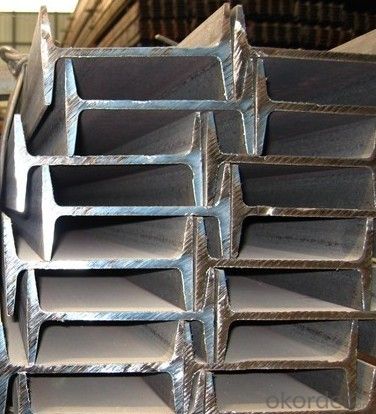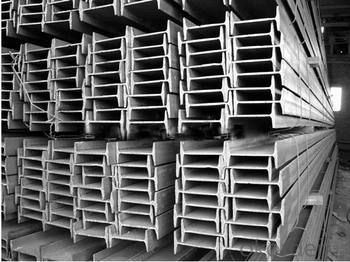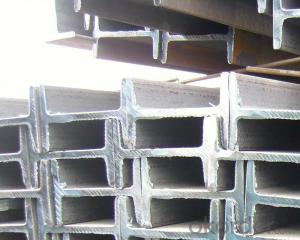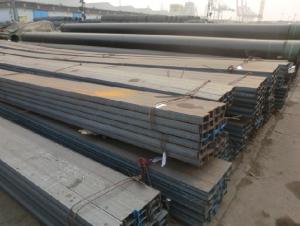Carbon stainless steel I-Beam for construction
- Loading Port:
- Tianjin
- Payment Terms:
- TT or LC
- Min Order Qty:
- 25 m.t.
- Supply Capability:
- 100000 m.t./month
OKorder Service Pledge
OKorder Financial Service
You Might Also Like
Product Description:
OKorder is offering carbon stainless steel I-Beam for construction at great prices with worldwide shipping. Our supplier is a world-class manufacturer of steel, with our products utilized the world over. OKorder annually supplies products to European, North American and Asian markets. We provide quotations within 24 hours of receiving an inquiry and guarantee competitive prices.
Product Applications:
Carbon stainless steel I-Beam are ideal for structural applications and are widely used in the construction of buildings and bridges, and the manufacturing, petrochemical, and transportation industries.
Product Advantages:
OKorder's steel I-Beam are durable, strong, and resist corrosion.
Main Product Features:
· Premium quality
· Prompt delivery & seaworthy packing (30 days after receiving deposit)
· Corrosion resistance
· Can be recycled and reused
· Mill test certification
· Professional Service
· Competitive pricing
Product Specifications:
Specifications of Hot Rolled H-Beam Steel
1. Standard: JIS G3101
2. Grade: SS400 or Equivalent
3. Length: 6m,10m, 12m as following table
4. Invoicing on theoretical weight or actual weight as customer request
5.Payment: TT or L/C
6. Sizes:
SIZE(mm) | DIMENSION(kg/m) |
100*100 | 16.9 |
125*125 | 23.6 |
150*75 | 14 |
150*150 | 31.1 |
148*100 | 20.7 |
198*99 | 17.8 |
200*100 | 20.9 |
248*124 | 25.1 |
250*125 | 29 |
300*150 | 36.7 |
298*149 | 32 |
200*200 | 49.9 |
294*200 | 55.8 |
346*174 | 41.2 |
350*175 | 49.4 |
244*175 | 43.6 |
175*175 | 40.4 |
294*200 | 55.8 |
298*201 | 64.4 |
346*174 | 41.2 |
350*175 | 49.4 |
400*200 | 65.4 |
396*199 | 56.1 |
450*200 | 74.9 |
446*199 | 65.1 |
340*250 | 78.1 |
500*200 | 88.1 |
300*150 | 36.7 |
Usage & Applications of Hot Rolled H-Beam Steel
Commercial building structure ;Pre-engineered buildings; Machinery support structure; Prefabricated structure; Medium scale bridges; Ship-building structure. etc.
Packaging & Delivery of Hot Rolled H-Beam Steel
1. Packing: it is nude packed in bundles by steel wire rod
2. Bundle weight: not more than 3.5MT for bulk vessel; less than 3 MT for container load
3. Marks:
Color marking: There will be color marking on both end of the bundle for the cargo delivered by bulk vessel. That makes it easily to distinguish at the destination port.
Tag mark: there will be tag mark tied up on the bundles. The information usually including supplier logo and name, product name, made in China, shipping marks and other information request by the customer.
If loading by container the marking is not needed, but we will prepare it as customer request.
4. Transportation: the goods are delivered by truck from mill to loading port, the maximum quantity can be loaded is around 40MTs by each truck. If the order quantity cannot reach the full truck loaded, the transportation cost per ton will be little higher than full load.
5. Delivered by container or bulk vessel
Production flow of Hot Rolled H-Beam Steel
Material prepare (billet) —heat up—rough rolling—precision rolling—cooling—packing—storage and transportation



FAQ:
Q1: Why buy Materials & Equipment from OKorder.com?
A1: All products offered byOKorder.com are carefully selected from China's most reliable manufacturing enterprises. Through its ISO certifications, OKorder.com adheres to the highest standards and a commitment to supply chain safety and customer satisfaction.
Q2: How do we guarantee the quality of our products?
A2: We have established an advanced quality management system which conducts strict quality tests at every step, from raw materials to the final product. At the same time, we provide extensive follow-up service assurances as required.
- Q:How do you calculate the bending stress in a steel I-beam?
- To calculate the bending stress in a steel I-beam, you need to consider the beam's moment of inertia, the applied load, and the distance from the neutral axis. First, determine the moment of inertia (I) of the I-beam. The moment of inertia is a mathematical property that represents the beam's resistance to bending. It depends on the dimensions of the beam's cross-section. You can usually find the moment of inertia value in engineering handbooks or structural design manuals. Next, determine the distance (c) from the neutral axis to the extreme fiber of the beam where the bending stress is highest. The neutral axis is the line through the beam's cross-section where there is no bending stress. The distance (c) can be calculated based on the geometry of the I-beam. Finally, calculate the bending stress (σ) using the following formula: σ = (M * c) / I Where: σ = Bending stress (in Pascals or psi) M = Applied bending moment (in Newton-meters or foot-pounds) c = Distance from the neutral axis to the extreme fiber (in meters or feet) I = Moment of inertia of the I-beam cross-section (in square meters or square feet) By plugging in the values for M, c, and I, you can calculate the bending stress in the steel I-beam. It's important to note that the bending stress should be compared to the allowable stress specified in the applicable design code or standard to ensure the beam can safely withstand the applied load.
- Q:What are the different connection methods for Steel I-Beams?
- There are several different connection methods for Steel I-Beams, depending on the specific application and structural requirements. Some of the common connection methods include: 1. Welding: This is the most common method used to connect steel I-beams. It involves melting the base metal and applying a filler material to create a strong joint. Welding provides excellent strength and rigidity, making it suitable for heavy-duty applications. 2. Bolting: Bolts can be used to connect steel I-beams together. This method involves drilling holes in the flanges or web of the I-beams and inserting bolts through these holes, along with washers and nuts, to tighten and secure the connection. Bolting provides ease of installation and disassembly, making it suitable for temporary or adjustable structures. 3. Riveting: Rivets are another traditional method of connecting steel I-beams. This process involves inserting a rivet through pre-drilled holes in the flanges or web of the I-beams and then deforming the rivet to create a permanent connection. Riveting provides high strength and reliability but requires specialized tools and expertise. 4. Adhesive bonding: In some cases, adhesive bonding can be used to connect steel I-beams. This method involves applying a high-strength adhesive to the surfaces of the I-beams and then pressing them together to create a bond. Adhesive bonding can provide a clean and aesthetically pleasing connection, but it may not be suitable for heavy loads or dynamic loads. 5. Mechanical connectors: There are various mechanical connectors available in the market specifically designed for connecting steel I-beams. These connectors are often prefabricated and can be easily installed by bolting or welding. They provide a quick and efficient method of connecting I-beams while maintaining high strength and load-bearing capacity. It is important to consider the specific structural requirements, load conditions, and design constraints when selecting the appropriate connection method for steel I-beams. Consulting with a structural engineer or a qualified professional is recommended to ensure the chosen connection method meets the necessary standards and specifications.
- Q:Can steel I-beams be used in coastal areas with high levels of salt exposure?
- While coastal areas with high levels of salt exposure can indeed utilize steel I-beams, it is imperative to implement specific measures to ensure their durability and longevity. The corrosion process of steel can be accelerated by salt exposure, resulting in rust and deterioration. Nevertheless, the implementation of corrosion-resistant coatings or materials like galvanized steel or stainless steel will enable the I-beams to endure the harsh coastal environment. Furthermore, it is essential to conduct regular maintenance and inspections to promptly detect any indications of corrosion and take appropriate actions to prevent further harm. Employing proper drainage systems and protective coatings can also minimize saltwater contact and mitigate the consequences of salt exposure. Overall, with the application of suitable precautions and maintenance practices, steel I-beams can be successfully employed in coastal areas with high levels of salt exposure.
- Q:How do steel I-beams handle vibrations from nearby railways or highways?
- Steel I-beams are designed to handle vibrations from nearby railways or highways efficiently. The structural properties of steel, combined with the I-beam shape, allow them to effectively absorb and distribute vibrations, minimizing their impact on the overall structure. Additionally, steel has a high stiffness-to-weight ratio, making it more resistant to vibrations compared to other materials. Overall, steel I-beams are a reliable choice for withstanding vibrations caused by nearby railways or highways.
- Q:How are steel I-beams installed on a construction site?
- Steel I-beams are installed on a construction site by first preparing the foundation or support structure. The beams are then lifted into place using cranes or other heavy machinery. They are carefully aligned and secured in position using bolts, welding, or a combination of both. Additional supports may be added as needed to ensure stability and structural integrity.
- Q:How do steel I-beams handle vibrations and dynamic loads?
- Steel I-beams are designed to handle vibrations and dynamic loads effectively due to their inherent structural characteristics. The shape of an I-beam, with its flanges and web, provides a high level of stiffness and strength, making it capable of withstanding dynamic loads and vibrations. One of the key features that enables I-beams to handle vibrations is their high moment of inertia. The shape of an I-beam distributes the material away from the neutral axis, resulting in a higher resistance to bending. This means that when subjected to vibrations or dynamic loads, the I-beam is less likely to deform or fail due to its stiffness. In addition, the flanges of the I-beam act as a sort of "skin" that reinforces the beam's overall strength. They help distribute the loads evenly along the length of the beam, reducing the concentration of stress points. This characteristic effectively absorbs and disperses the energy generated by vibrations or dynamic loads, preventing localized failures. Steel, as a material, also contributes significantly to the I-beam's ability to handle vibrations and dynamic loads. It possesses a high strength-to-weight ratio, allowing for the creation of lightweight yet robust structures. Steel's inherent durability and resilience make I-beams suitable for withstanding repetitive loads and vibrations without significant deformation or fatigue. Moreover, the design and fabrication of I-beams take into account the anticipated loads and vibrations that the structure will experience throughout its lifetime. Engineers consider factors such as the expected frequency, amplitude, and duration of the vibrations, as well as any potential resonance effects. By carefully analyzing and optimizing the design, I-beams can be tailored to effectively handle specific vibrations and dynamic loads. Overall, steel I-beams are well-equipped to handle vibrations and dynamic loads due to their high moment of inertia, the reinforcement provided by their flanges, and the inherent strength and resilience of steel as a material. Through careful design and engineering, these beams can effectively absorb and distribute the energy generated by vibrations, ensuring the stability and longevity of the structure they support.
- Q:How can I spray the fluorocarbon paint on the bottom of I-beam?
- Then primer, general primer with two-component epoxy primer, or epoxy zinc rich primer, primer can enhance adhesion, has a strong rust resistance.
- Q:What are the design considerations for steel I-beams in high-seismic zones?
- The design considerations for steel I-beams in high-seismic zones primarily revolve around ensuring their stability and resistance to seismic forces. Some key considerations include selecting an appropriate beam size and shape, ensuring sufficient material strength, providing adequate bracing and connections, and employing proper detailing and reinforcement techniques. Additionally, the design should account for factors such as the building's location, soil conditions, anticipated ground motion, and any applicable building codes or regulations. Overall, the goal is to design I-beams that can effectively withstand seismic forces and minimize potential damage or failure during earthquakes.
- Q:How do you protect steel I-beams against impact loads?
- To protect steel I-beams against impact loads, several measures can be taken: 1. Install impact-resistant barriers: One effective way to protect steel I-beams is to install impact-resistant barriers, such as bollards or guardrails, around the area. These barriers act as a buffer, absorbing and dispersing the impact energy before it reaches the beams. 2. Use impact-resistant coatings: Applying impact-resistant coatings to the surface of the steel I-beams can provide an additional layer of protection. These coatings are designed to absorb and dissipate impact forces, reducing the likelihood of damage to the beams. 3. Employ shock-absorbing materials: Another method is to use shock-absorbing materials, such as rubber or foam, between the I-beams and potential sources of impact. These materials can absorb and disperse the energy from an impact, minimizing the stress on the beams. 4. Implement proper structural design: Ensuring that the I-beams are designed and installed correctly is essential for protecting them against impact loads. This includes considering factors such as load distribution, beam size and spacing, and proper fastening techniques. 5. Conduct regular inspections and maintenance: Regular inspections of the steel I-beams can help identify any signs of damage or stress. Prompt repairs or reinforcement can then be carried out to prevent further deterioration and maintain the beams' structural integrity. By implementing these protective measures, steel I-beams can be safeguarded against impact loads, reducing the risk of structural damage and ensuring their longevity and safety.
- Q:Are there any differences between the two prices of I-beam and H steel?
- I-steel whether ordinary or light, because the section size are relatively high and narrow, so the moment of inertia of the main sections of the two sleeve is large, therefore, generally only can be directly used in the web plane bending member or the composition of lattice stress components. It is not suitable for the axial compression member or the bent member perpendicular to the web plane, which has great limitations in its application.
1. Manufacturer Overview |
|
|---|---|
| Location | |
| Year Established | |
| Annual Output Value | |
| Main Markets | |
| Company Certifications | |
2. Manufacturer Certificates |
|
|---|---|
| a) Certification Name | |
| Range | |
| Reference | |
| Validity Period | |
3. Manufacturer Capability |
|
|---|---|
| a)Trade Capacity | |
| Nearest Port | |
| Export Percentage | |
| No.of Employees in Trade Department | |
| Language Spoken: | |
| b)Factory Information | |
| Factory Size: | |
| No. of Production Lines | |
| Contract Manufacturing | |
| Product Price Range | |
Send your message to us
Carbon stainless steel I-Beam for construction
- Loading Port:
- Tianjin
- Payment Terms:
- TT or LC
- Min Order Qty:
- 25 m.t.
- Supply Capability:
- 100000 m.t./month
OKorder Service Pledge
OKorder Financial Service
Similar products
New products
Hot products
Related keywords






























